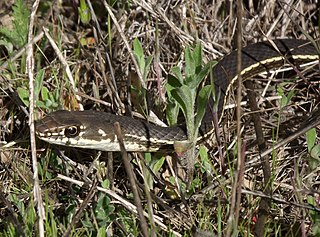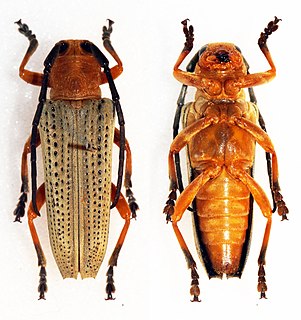Related Research Articles

The golden-mantled ground squirrel is a ground squirrel native to western North America. It is distributed in British Columbia and Alberta through the western United States to California, Arizona, and New Mexico.

The quadriceps femoris muscle is a large muscle group that includes the four prevailing muscles on the front of the thigh.

The rectus capitis lateralis, a short, flat muscle, arises from the upper surface of the transverse process of the atlas, and is inserted into the under surface of the jugular process of the occipital bone.

The vastus lateralis, also called the ''vastus externus'' is the largest and most powerful part of the quadriceps femoris, a muscle in the thigh. Together with other muscles of the quadriceps group, it serves to extend the knee joint, moving the lower leg forward. It arises from a series of flat, broad tendons attached to the femur, and attaches to the outer border of the patella. It ultimately joins with the other muscles that make up the quadriceps in the quadriceps tendon, which travels over the knee to connect to the tibia. The vastus lateralis is the recommended site for intramuscular injection in infants less than 7 months old and those unable to walk, with loss of muscular tone.

The black-flanked rock-wallaby, also known as the black-footed rock-wallaby or warru, is a species of wallaby, one of several rock-wallabies in the genus Petrogale.

The California whipsnake also known as the striped racer, is a colubrid snake found in habitats of the coast, desert, and foothills of California.

Mulinia lateralis, the dwarf surf clam or coot clam, is a species of small saltwater clam, a bivalve mollusc in the family Mactridae. It occurs in the western Atlantic Ocean and the Caribbean Sea.

Saperdini is a tribe of longhorn beetles of the subfamily Lamiinae.

Stibara is a genus of longhorn beetles of the subfamily Lamiinae, containing the following species:
Stibara cambodjensis is a species of beetle in the family Cerambycidae. It was described by Masao Hayashi in 1964.
Stibara humeralis is a species of beetle in the family Cerambycidae. It was described by James Thomson in 1865. It is known from Myanmar.
Stibara morbillosa is a species of beetle in the family Cerambycidae. It was described by Johan Christian Fabricius in 1798, originally under the genus Saperda. It is known from India.

Stibara nigricornis is a species of beetle in the family Cerambycidae. It was described by Johan Christian Fabricius in 1781.
Stibara nigrovittata is a species of beetle in the family Cerambycidae. It was described by Stephan von Breuning in 1954. It is known from Myanmar and India.
Stibara rufina is a species of beetle in the family Cerambycidae. It was described by Francis Polkinghorne Pascoe in 1858. It contains the varietas Stibara rufina var. laosensis.
Stibara subpunctata is a species of beetle in the family Cerambycidae. It was described by Stephan von Breuning in 1954.
Stibara suturalis is a species of beetle in the family Cerambycidae. It was described by Charles Joseph Gahan in 1890. It is known from India.

Stibara tetraspilota is a species of beetle in the family Cerambycidae. It was described by Frederick William Hope in 1840. It is known from Thailand, Myanmar, India, and Vietnam.

Stibara tricolor is a species of beetle in the family Cerambycidae. It was described by Johan Christian Fabricius in 1792, originally under the genus Saperda. It is known from Myanmar, India, China, Thailand, Malaysia, and Vietnam.
Stibara trilineata is a species of beetle in the family Cerambycidae. It was first described by Frederick William Hope in 1840.
References
- ↑ BioLib.cz - Stibara lateralis. Retrieved on 8 September 2014.
| This Saperdini article is a stub. You can help Wikipedia by expanding it. |